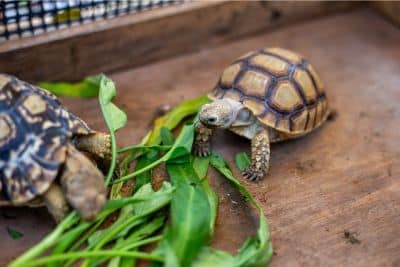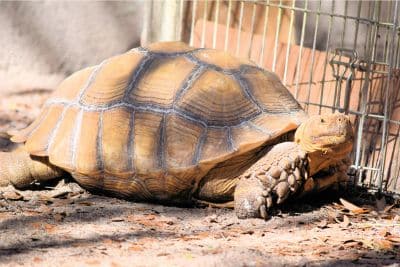No matter what kind of animal you care for, mental enrichment matters. No pet should be forced to live in an empty habitat with nothing to explore, manipulate, or interact with—and that absolutely includes tortoises.
Here’s what catches many tortoise owners off guard: these slow-moving reptiles are actually much more intelligent than most people realize. Research shows tortoises can remember tasks up to nine years later. They’re trainable, curious, and capable of experiencing the full range of emotions that other animals do.
Without adequate enrichment, tortoises get bored. Bored tortoises become stressed, lethargic, and may develop harmful behaviors like excessive shell rubbing or biting at objects. Some stressed tortoises actually become more active than happy ones—but not in a good way. They pace, attempt to escape, and show signs of distress.
The solution? Providing appropriate tortoise toys and enrichment activities that encourage natural behaviors, support mental stimulation, and promote physical activity.
This guide covers the best enrichment items you can add to your tortoise’s habitat, plus fun activities that’ll make their daily life more interesting and enjoyable. Whether you have a tiny hatchling or a massive adult, these ideas will help ensure your tortoise lives a full, engaging life.
- Understanding What Tortoises Actually Need
- The 9 Best Tortoise Toys and Enrichment Items
- Enrichment Activities Beyond Tortoise Toys
- Important Safety Considerations for Tortoise Toys
- Age-Appropriate Tortoise Toys and Enrichment
- Species-Specific Considerations
- The Bottom Line on Tortoise Toys and Enrichment
- Give Your Tortoise Everything They Need to Thrive
Understanding What Tortoises Actually Need
Before we dive into specific tortoise toys and enrichment ideas, let’s clarify something important: tortoises don’t need “toys” in the same way dogs, cats, or birds do.
They’re not going to fetch a ball or play with a feather on a string. Their idea of fun is different—more about exploration, foraging, climbing, and manipulating their environment than what we typically think of as “play.”
In the wild, tortoises spend their days:
- Walking long distances in search of food
- Climbing over obstacles
- Digging and burrowing
- Grazing on varied vegetation
- Exploring different terrain types
- Using their strong sense of smell to locate food
The best tortoise toys and enrichment activities mimic these natural behaviors. When you provide opportunities for your tortoise to do what they’re built to do, you support both their physical health and mental well-being.
The 9 Best Tortoise Toys and Enrichment Items
These enrichment items all work well for tortoises and provide genuine mental stimulation without creating stress or safety hazards.
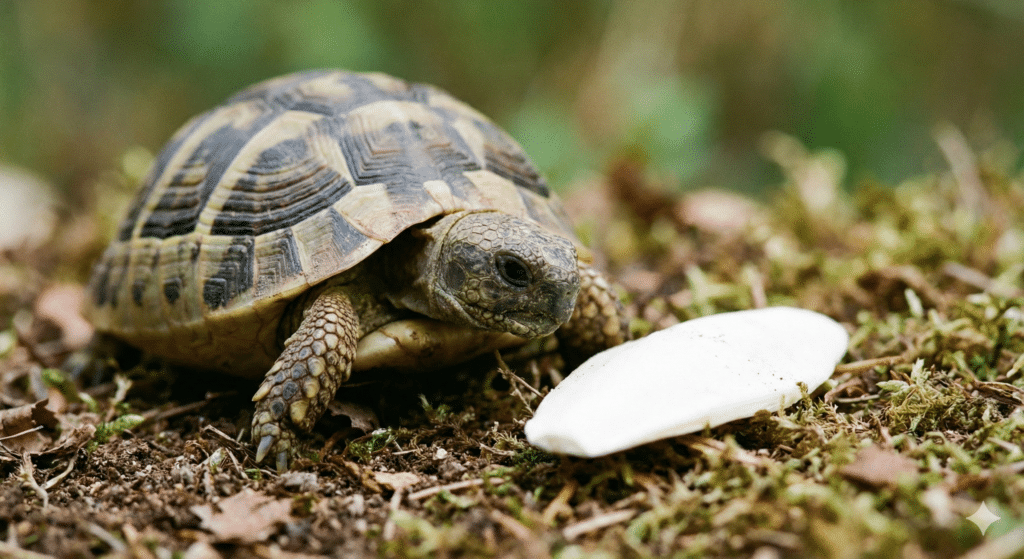
1. Cuttlebone
Cuttlebones—the internal shells of cuttlefish—serve double duty as both nutrition and enrichment. Most tortoises voluntarily consume cuttlebone as needed to meet their calcium requirements, and the effort required to break off and eat small pieces provides mental stimulation.
For additional enrichment value, move cuttlebone pieces to different locations throughout the enclosure periodically. This encourages your tortoise to use their sense of smell to hunt for the calcium source, mimicking natural foraging behavior.
Cuttlebone is one of the easiest tortoise toys to implement because it’s inexpensive, safe, and naturally appeals to your pet’s dietary needs.
2. Unusual or Interesting Foods
While you should always select foods based on nutritional value and your tortoise’s species-specific dietary needs, varying the diet provides excellent enrichment.
New food items give your tortoise something interesting to explore, sniff, and figure out how to consume. This mental challenge is valuable even if they only spend a few minutes investigating.
Great options include:
- Seasonally available items like spineless cactus pads
- Wild-collected plants (dandelions, clover, plantain) from pesticide-free areas
- Whole foods that require effort to eat (chunks of squash, large pieces of leafy greens)
- Edible flowers like hibiscus, nasturtium, or roses
Presenting food in different ways adds enrichment too. Instead of chopped vegetables in a bowl, try hanging leafy greens from a clip so your tortoise has to stretch up to eat. Hide small pieces of favorite foods around the enclosure to encourage foraging.
Quality nutrition supports not just physical health but also the energy and curiosity needed for engagement with enrichment activities. TheBaby Sulcata Superfood Powder provides complete, balanced nutrition for growing tortoises, ensuring they have the vitality to stay active and curious about their environment.
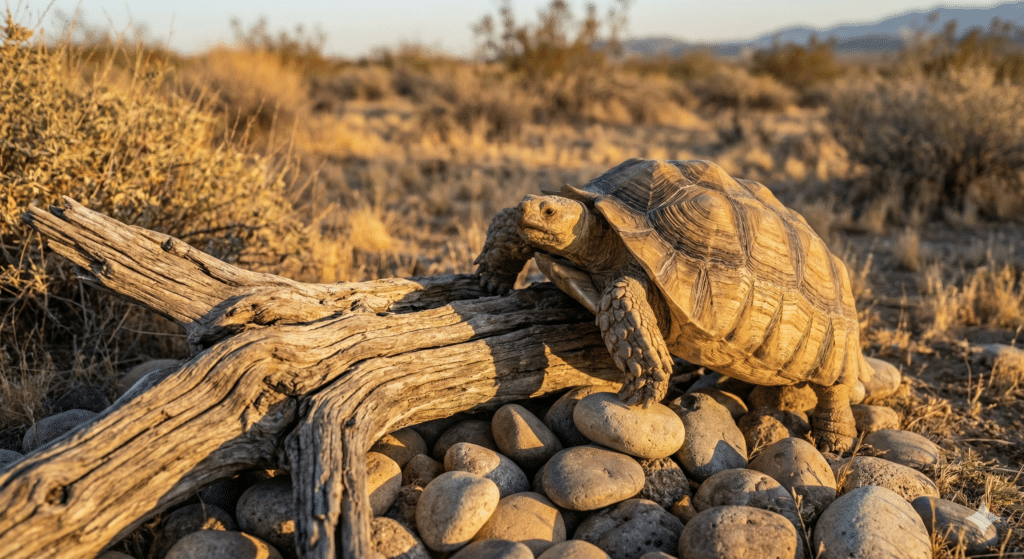
3. Natural Wood Items
Driftwood, grapevine, and large branches from tortoise-safe tree species (like oak, maple, or mulberry) all provide interesting things for your tortoise to explore, climb on, and navigate around.
Stick to non-sappy species and always clean wood thoroughly before adding it to the enclosure. Hot water and a stiff wire brush work well, or you can sand the wood to remove surface contaminants.
Choose lightweight pieces so they won’t present a crushing hazard if they shift or fall. Arrange wood items to create obstacles your tortoise has to navigate around—this encourages movement and exploration.
Different sizes and arrangements keep things interesting. Swap out wood pieces during deep cleaning sessions to provide novel items for your tortoise to investigate.
4. Rocks of Varying Shapes and Sizes
Rocks and stones make excellent tortoise toys because they’re affordable (often free), durable, easy to clean, and completely safe when set up properly.
Rocks offer climbing opportunities, which is especially valuable for species like pancake tortoises who naturally clamber on rocky terrain. Even species that don’t typically climb appreciate having different elevations to explore.
Critical safety tip: Always place rocks directly on the floor of the habitat, not on top of substrate. This prevents your tortoise from being crushed if they burrow beneath a rock. Bury the bottom portion of larger rocks in substrate to stabilize them.
Flat rocks can create basking platforms. Grouped rocks create hiding spots. Rocks arranged in lines create obstacles that break up sight lines and encourage your tortoise to walk further to see their entire enclosure.
Are You Starving Your Tortoise?
Save 10% on premium tortoise food and supplements from Tortoise Resource Center on Amazon now using code BUYNOWGET10
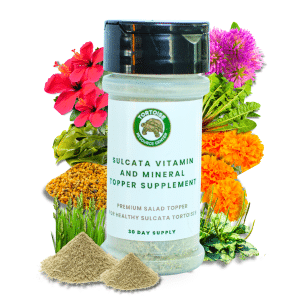
Sulcata Vitamin & Mineral Topper Supplement
30-Day Supply | 2 oz (56 g)
$24.99
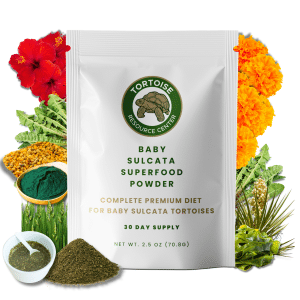
Baby Sulcata Tortoise Superfood Powder
30-Day Supply | 2.5 oz (70.8 g) Bag
$24.99
5. Commercial Habitat Decorations
Pet stores offer various reptile enclosure decorations that can provide enrichment value. These include hollow logs, caves, decorative ruins, bridges, and more.
The key is selecting items made from safe, non-toxic materials without sharp edges or small parts that could present injury hazards.
Hollow logs and caves give your tortoise places to hide and feel secure—important for stress management. Bridges and elevated platforms (with proper safety rails to prevent falls) encourage climbing and give your tortoise different perspectives on their environment.
Rotate decorations periodically to keep the environment interesting. Having a collection of items you swap in and out means your tortoise regularly encounters “new” things to explore without the stress of completely redesigning their space.
6. Different Substrate Types
Choose your primary substrate based on your tortoise’s species-specific environmental needs. For example, cypress mulch works well for humidity-loving red-footed tortoises, while a dry soil-and-sand mix suits desert dwellers like sulcatas.
However, you can create enrichment by providing a small area with a different substrate type. This gives your tortoise varied textures to experience and may encourage natural digging and burrowing behaviors.
Try creating distinct zones:
- A sandy area for digging
- A grassy section for grazing
- A rocky area for climbing
- A deeper substrate section for burrowing
Different walking surfaces engage your tortoise’s senses and encourage them to explore their entire habitat rather than staying in one favorite spot.
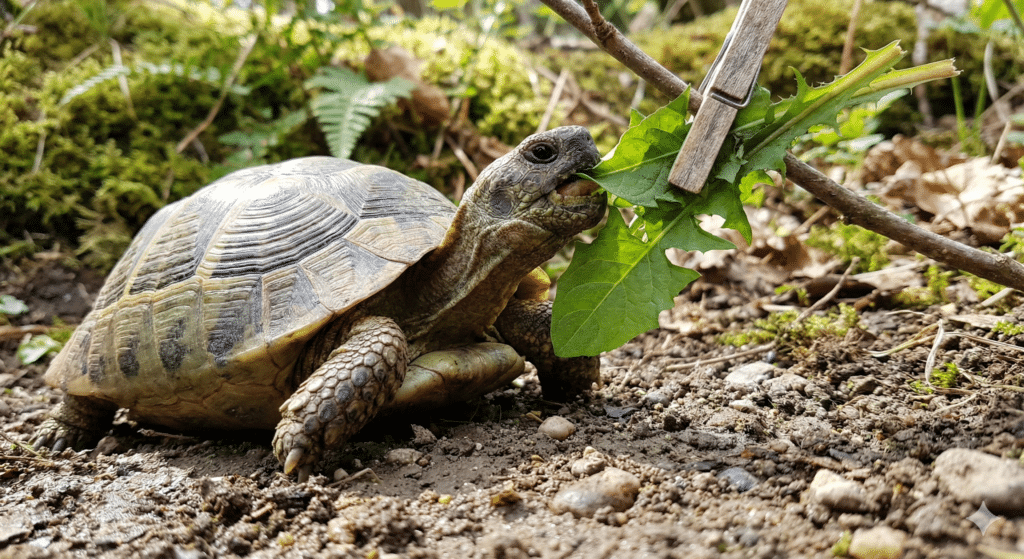
7. Live, Non-Toxic Plants
Live plants are among the best tortoise toys and enrichment items you can provide—as long as you choose non-toxic species. Never use artificial plants, as tortoises may try to eat them and risk intestinal obstruction.
Live plants offer multiple benefits:
- Places to hide and feel secure
- Interesting odors to investigate
- Edible options your tortoise can graze on
- More naturalistic, visually appealing habitat
Excellent plant options include:
- Hibiscus (flowers and leaves are edible)
- Mulberry trees
- Fig trees (if you have the space)
- Aloe plants
- Grasses and edible weeds
For indoor enclosures, use potted plants and bury the pot in substrate to prevent tipping. Outdoor habitats can feature plants both inside and around the enclosure perimeter.
Expect your tortoise to eat, trample, or destroy some plants—this is part of natural behavior. Having a mix of “keeper” plants in protected pots and “disposable” plants for grazing works well.
8. Ramps and Bridges
Though you must be mindful of fall risks, you can safely include homemade ramps and bridges in your tortoise’s enclosure. Add rails or sidewalls to reduce the risk enough to make them appropriate enrichment items.
Ramps and bridges encourage:
- Physical exercise
- Problem-solving (figuring out how to navigate the structure)
- Different perspectives on the environment
- Natural climbing behaviors
Keep heights minimal—even a fall from a few inches can injure a tortoise. Ensure all structures are stable and can’t shift or collapse. Use textured surfaces so your tortoise gets good traction.
Multi-level habitats create more usable space in the same footprint, which is valuable if you’re limited on floor space.
9. Another Tortoise (With Important Caveats)
We certainly wouldn’t call another tortoise a “toy,” but the companionship does provide considerable enrichment value. However, this comes with significant caveats.
If you’re considering adding another tortoise:
- Must be the same species
- Ensure compatibility before permanent housing together
- Quarantine new tortoises for 60-90 days minimum
- Confirm new tortoise is healthy and parasite-free via vet check
- Research whether your species does better with same-sex or opposite-sex pairings
- Provide significantly more space (at least double your current setup)
- Have hiding spots so tortoises can get away from each other if needed
Some tortoises are naturally more social than others. Russians tend to do okay with companions. Sulcatas can work in groups with adequate space. Some species are more territorial and prefer solitary living.
Don’t add another tortoise solely for enrichment purposes—only do it if you genuinely want multiple tortoises and can provide appropriate care for both.
Enrichment Activities Beyond Tortoise Toys
In addition to adding items to the enclosure, there are activities you can offer that provide mental stimulation and physical exercise.
Supervised Outdoor Walkabouts
Taking your tortoise outside to explore your yard is wonderful enrichment, especially for indoor-housed tortoises. Even tortoises living outdoors benefit from exploring new areas beyond their usual territory.
Safety is critical:
- Supervise constantly—tortoises disappear into vegetation remarkably quickly
- Check the area for toxic plants, pesticides, or other hazards
- Ensure appropriate temperatures (warm enough but not too hot)
- Watch for predators
- Bring your tortoise back inside before they get too tired
Outdoor time provides natural sunlight, interesting smells, varied terrain, and genuine adventure that captive environments can’t fully replicate.
Rain Showers and Water Play
Many tortoises seem to enjoy “playing” in rain. You can take your tortoise outside during warm rain showers (avoid cold weather, lightning, or thunder). Or create your own rain using a lawn sprinkler or gentle garden hose spray.
Water play provides:
- Hydration through both drinking and absorption
- Sensory stimulation from water droplets
- Temperature regulation on warm days
- Novel experience that breaks up routine
Some tortoises get surprisingly active during rain, walking around more than usual and appearing to deliberately position themselves under falling water.
Field Trips to New Locations
Don’t limit outdoor adventures to your property. Take your tortoise on field trips to safe locations like pesticide-free parks or nature preserves. Always check with property managers first to ensure you’re following rules.
Some dedicated tortoise owners even take their pets to pet-friendly stores. However, this exposes your tortoise to potential diseases from other animals, so weigh the enrichment value against health risks carefully.
New environments provide immense mental stimulation—new smells, different terrain, varied vegetation, and completely novel surroundings to explore.
Training and Problem-Solving Activities
Tortoises are surprisingly trainable using operant conditioning. You can teach them to come when called, navigate simple mazes, or perform basic tasks for food rewards.
Training provides:
- Mental challenge and problem-solving opportunities
- Bonding time with you
- Practical benefits (easier to call your tortoise inside, for instance)
- Proof of tortoise intelligence that makes them even more fascinating
Start simple—use a consistent signal (tapping, hand gesture, verbal cue) paired with a high-value food reward. Be patient. Training sessions should be short, positive, and happen at your tortoise’s pace.
Foraging Challenges
Instead of placing all food in one bowl, create foraging opportunities:
- Scatter food throughout the enclosure
- Hide favorite treats under leaves or in corners
- Use puzzle feeders designed for dogs or cats
- Place food at different elevations
- Hang leafy greens from clips
These challenges engage your tortoise’s excellent sense of smell and problem-solving abilities while providing physical exercise as they search for food.
TheVitamin and Mineral Topper can be dusted on favorite foods hidden around the enclosure, combining essential nutrition with enrichment value.
Regular Enclosure Rearrangement
While tortoises generally prefer routine and can find excessive change stressful, periodic rearrangement provides valuable novelty.
Every few weeks, move items to different locations. Swap out some decorations for others from your collection. Create new hiding spots. Change where you place food and water dishes (though keep them accessible).
This encourages your tortoise to re-explore their entire habitat rather than developing rigid routines where they only visit certain areas.
Important Safety Considerations for Tortoise Toys
Not all enrichment is created equal. Keep these safety guidelines in mind:
Avoid items that:
- Have sharp edges or protruding parts
- Are small enough to swallow
- Contain toxic materials or paints
- Could trap head, legs, or body
- Present crushing hazards if they fall or shift
- Create fall risks from excessive height
Always:
- Supervise new enrichment items until you’re confident they’re safe
- Clean items regularly to prevent bacterial growth
- Inspect for wear and damage before each use
- Consider your specific tortoise’s size, strength, and behaviors
- Remove items if they cause stress rather than engagement
Watch for stress signals:
- Attempting to escape
- Excessive hiding
- Loss of appetite
- Changes in breathing pattern
- Frantic activity or pacing
- Biting at items aggressively rather than exploring curiously
If enrichment causes stress, remove it. Not every tortoise enjoys the same things, and forcing interaction defeats the purpose.
Age-Appropriate Tortoise Toys and Enrichment
Different life stages benefit from different types of enrichment.
Hatchlings and juveniles:
- Need more hiding spots and cover
- Benefit from easily navigable climbing structures
- Enjoy varied food presentations
- Need age-appropriate substrate depth for burrowing
- Should have frequent but brief enrichment sessions
Adults:
- Can handle more complex climbing structures
- Benefit from larger foraging areas
- Enjoy more challenging problem-solving activities
- May appreciate companion tortoises (species-dependent)
- Need continued enrichment to prevent boredom
Elderly tortoises:
- May have reduced mobility requiring easier navigation
- Still need mental stimulation even with decreased activity
- Benefit from easily accessed hiding spots
- Should have food placed more accessibly if arthritis is present
- Continue enjoying sensory enrichment like varied foods and scents
Species-Specific Considerations
Different tortoise species have different natural behaviors to encourage:
Grassland species (Sulcatas, Russians): Need lots of walking space, benefit from obstacles that increase travel distance, enjoy different substrate textures.
Forest species (Red-foots, Yellow-foots): Need high humidity maintained during enrichment activities, benefit from live plants and climbing opportunities, enjoy varied diet presentations.
Desert species (Egyptian tortoises): Need hiding spots for security, benefit from morning misting or fog, enjoy digging opportunities in appropriate substrate.
Climbing-adapted species (Pancake tortoises): Need secure climbing structures, benefit from elevated food placement, enjoy rock arrangements.
Research your specific species’ natural behaviors and habitat to tailor enrichment appropriately.
The Bottom Line on Tortoise Toys and Enrichment
Tortoises are intelligent, curious animals who need and deserve mental stimulation. While they don’t play with toys the way mammals do, they absolutely benefit from enrichment that encourages natural behaviors.
The best tortoise toys and enrichment activities provide opportunities for foraging, exploration, climbing, problem-solving, and environmental manipulation. These activities support both physical health through exercise and mental health through cognitive engagement.
Start with simple additions like interesting foods, natural wood items, and varied substrates. As you learn what your specific tortoise enjoys, expand to more elaborate setups and activities.
Remember that enrichment should be species-appropriate, age-appropriate, and tailored to your individual tortoise’s personality. What one tortoise loves, another might ignore or find stressful. Pay attention to your pet’s responses and adjust accordingly.
The investment you make in providing proper tortoise toys and enrichment pays off in a happier, healthier, more engaged companion who’ll be with you for decades. These long-lived animals deserve environments that support their well-being and allow them to express natural behaviors throughout their entire lives.
Give Your Tortoise Everything They Need to Thrive
Want to create the ultimate enrichment experience for your tortoise? You need more than just tortoise toys—you need the knowledge and community support to provide truly excellent care.
Discover proven strategies from experienced tortoise keepers and get instant access to resources that transform your tortoise’s quality of life:
Save on Premium Nutrition and Supplies – Get exclusive discounts on the high-quality food and supplements that fuel your tortoise’s energy for active, engaged living
Complete Tortoise Care Ebook – Download “The Ultimate Guide to Tortoise Nutrition” covering species-specific dietary needs, foraging strategies, and feeding approaches that naturally enrich your tortoise’s daily routine
Expert Habitat Design Training – Access “The Ultimate Sulcata Care Webinar” with detailed guidance on creating stimulating environments that encourage natural behaviors and keep tortoises mentally sharp
Supportive Community – Join our private Facebook group where thousands of tortoise owners share their best enrichment ideas, troubleshoot challenges, and celebrate their pets’ personalities together
Behavior Tracking Templates – Download tools for monitoring your tortoise’s engagement with different enrichment items so you can identify what works best for your individual pet
Active, curious, mentally engaged tortoises are healthier and live longer. Our community has the collective experience of decades of successful tortoise keeping, and we’re excited to share what actually works (and what doesn’t) when it comes to enrichment.
Join the community and get your free resources →
Citations
- California Turtle & Tortoise Club – Growing Plants for Tortoise Yards
- Tortoise Library – Enrichments
- SciTechDaily – Tortoises Have Amazing Long-Term Memory and Greatly Underestimated Intelligence

